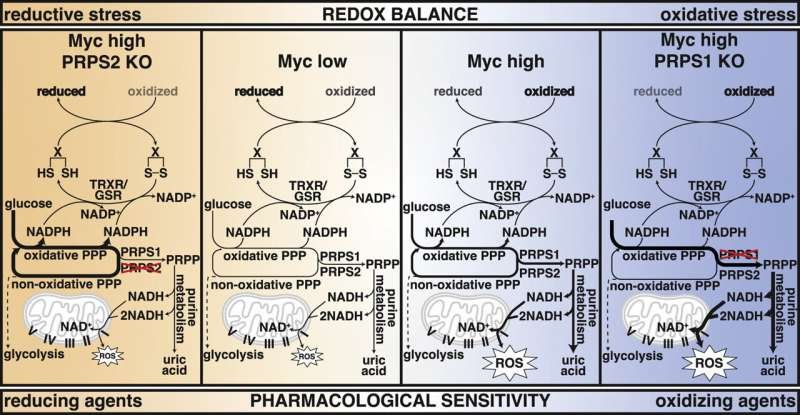
A study led by University of Cincinnati Cancer Center researchers sheds new light on the mechanisms by which a major oncogene promotes and sustains lymphoma development and progression, paving the way for novel targeted therapies.
The research, led by first author Austin C. MacMillan and senior author Tom Cunningham, is published in the journal Redox Biology.
The Cunningham lab focuses on an oncogene called MYC that “turbocharges” the metabolism of cancer cells to fuel their aggressive growth and proliferation. Although many of the numerous individual pathways and processes that are engaged when MYC becomes unleashed are already known, the precise order and manner with which they coordinate with one another to drive cancer is still poorly understood.
Previous research has demonstrated that one sprawling collection of metabolic processes under direct control of MYC are those responsible for maintaining redox homeostasis, the constant balancing between oxidative and reductive states that must be tightly regulated to maintain cellular processes and prevent cancer cell death.
“Think of the cell as a battery, and you’ve got negative charges and positive charges constantly exchanging between molecules and different compartments,” said Cunningham, Ph.D., a Cancer Center researcher and associate professor in the Department of Cancer Biology in UC’s College of Medicine. “A reductive state means that something acquires or gains electrons, and an oxidized state means it loses them.”
Too much oxidative or reductive stress in cells can tip the balance of redox homeostasis to leave them more vulnerable, so damaging cancer cells’ redox functions is one approach to weaken or kill cancer cells.
The team examined the role of an enzyme called phosphoribosyl pyrophosphate synthetase (PRPS) that is present in lymphoma cells in two forms: PRPS1 and PRPS2. Using CRISPR gene editing technology, the team knocked out either form of the enzyme in lymphoma cell line models.
The researchers found that PRPS1 and PRPS2 have different activities but work together in the same biochemical complex, with PRPS2 increased and more active in lymphoma cells where MYC is overexpressed.
“The PRPS enzymes and the PRPS complex have a cell-wide effect on redox homeostasis,” said MacMillan, a doctoral cancer biology student in Cunningham’s lab. “The many buffering mechanisms in place to regulate redox homeostasis make it very uncommon to find that the difference in catalyzation of a single biochemical reaction produces such a measurable change in the cell’s global redox state, so that was a major surprise.”
Eliminating PRPS1’s function enhanced sensitivity to oxidative stressors and damage within cells, while eliminating PRPS2’s function triggered reductive stress. Essentially, the team found that MYC remodels the PRPS complex for its own purposes, but it is possible for researchers and clinicians to hack this critical metabolic node and make the cells more vulnerable to a variety of new or existing therapies.
“Disabling PRPS2 turns out to be one of only a handful of loss of function strategies we know of that can induce reductive stress,” MacMillan said.
“There are so many checks and balances, so many ways of recalibrating that cellular redox state to keep it stable. Discovering that changing flux through the single PRPS enzyme can have such profound consequences on the overall cellular redox state,” Cunningham added. “Having the molecular tools at our disposal to harness that is a really powerful bit of knowledge that we can use in the future.”
The novel findings from this study set the lab up to perform preclinical testing and screening to find additional drugs and pathways capable of pushing lymphoma cells even further from their desired redox state, the next step toward developing more efficacious therapeutic strategies to be tested in human clinical trials.
Cunningham said the team is currently developing and testing different approaches to manipulate the PRPS enzyme that could be used for therapeutic purposes and work in combination with other treatments such as chemotherapies to eradicate aggressive lymphomas overexpressing MYC.
Other co-authors include Bibek Karki, Juechen Yang, Karmela Gertz, Samantha Zumwalde, Jay Patel, Maria Czyzyk-Krzeska and Jarek Meller.
More information:
Austin C. MacMillan et al, PRPS activity tunes redox homeostasis in Myc-driven lymphoma, Redox Biology (2025). DOI: 10.1016/j.redox.2025.103649
University of Cincinnati
Citation:
Study sheds light on enzyme’s role in driving lymphoma growth (2025, May 29)
retrieved 29 May 2025
from https://medicalxpress.com/news/2025-05-enzyme-role-lymphoma-growth.html
This document is subject to copyright. Apart from any fair dealing for the purpose of private study or research, no
part may be reproduced without the written permission. The content is provided for information purposes only.

